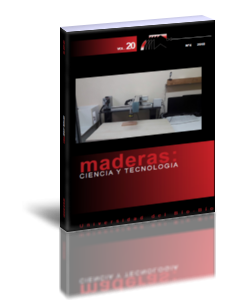Asbestos-free autoclaved wood fiber-cement sheets from recycled old corrugated containers and kraft pulp of douglas fir: Properties and scanning electron microscopy
Keywords:
Fiber refining, kappa number, mechanical properties, physical properties, Pseudotsuga menziesiiAbstract
This study was conducted in cooperation with a United States pulp and paper company targeting part of the pulp production as raw material for fiber-reinforced cement sheets manufacturing. Virgin kraft pulp of Douglas fir (Pseudotsuga menziesii) and recycled fiber of old corrugated containers were used in making wood fiber-cement flat sheets. The physical and mechanical properties of the sheets were compared with an available commercial product. Results showed that Douglas fir fiber is a potential choice as reinforcement for wood fiber-cement sheets, as this fiber type outperformed the commercial ones for most of the properties studied. The difference in kappa number from 25 to 35 did not have any effect on the properties of Douglas fir sheets. Even recycled old corrugated containers fiber provided sheets with some properties comparable to the commercial product. Scanning electron microscopy analysis showed that a dual mechanism of fiber breakage and pull out occurred at rupture.
Downloads
References
AF&PA-American Forest & Paper Association. 2018. Recovery & use of old corrugated containers (OCC). Available at <http://www.paperrecycles.org/>. Access: July 17, 2018.
AF&PA-American Forest & Paper Association. 2018. Recovery of old newspapers/mechanical papers. Available at <http://www.paperrecycles.org/> Accessed: July 17, 2018.
Alda, J.A.G.O.; Torrea, J.A. 2006. Applications of recycled paper mills effluents to wood substitute products (RESPRO): executive Summary. Oppidium, Universidad SEK, no. 2, pp. 381–398.
Almeida, R. R.; Del Menezzi, C.H.S.; Teixeira, D.E. 2002. Utilization of the coconut shell of babaçu (Orbignya sp.) to produce cement-bonded particleboard. Bioresource Technology 85(2): 159–163.
Araújo, P.C.; Arruda, L.M.; Del Menezzi, C.H.S.; Teixeira, D.E.; Souza, M.R. 2011. Lignocellulosic composites from Brazilian giant bamboo (Guadua magna). Part 2: properties of cement and gypsum bonded particleboards. Maderas-Cienc Tecnol 13(3): 297–306.
Ardanuy, M.; Claramunt, J.; Toledo Filho, R.D. 2015. Cellulosic fiber reinforced cement-based composites: a review of recent research. Construction and Building Materials 79: 115–128.
ASTM C 1185. 2008. Standard test methods for sampling and testing non-asbestos fiber-cement flat sheet, roofing and siding shingles, and clapboards. Annual Book of the ASTM Standards, Volume 04.05. American Society for Testing and Materials. Philadelphia, PA.
ASTM C 1186-91. 2008. Standard specification for flat non-asbestos fiber-cement sheets. Annual Book of the ASTM Standards, Volume 04.05. American Society for Testing and Materials. Philadelphia, PA.
ASTM D 1037. 2006. Standard methods of evaluating the properties of wood-base fiber and particle panel materials. Annual Book of the ASTM Standards, Volume 04.10. American Society for Testing and Materials. Philadelphia, PA.
Cheng, X.W.; Khorami, Morteza; Shi, Y.; Liu, K.Q.; Guo, X.Y.; Austin, S.; Saidani, M. 2018. A new approach to improve mechanical properties and durability of low-density oil well cement composite reinforced by cellulose fibres in microstructural scale. Construction and Building Materials 177: 499-510. https://doi.org/10.1016/j. conbuildmat. 2018.05.134.
Farrapo, Camila L.; Fonseca, Camila S.; Pereira, Tamires G.T.; Tonoli, Gustavo H.D.; Savastano Junior, Holmer; Mendes, Rafael F. 2017. Cellulose associated with pet bottle waste in cement based composites. Materials Research 20(5): 1380-1387. https://dx.doi.org/10.1590/1980-5373-mr-2017-0183.
Ferraz, J.M.; Del Menezzi, C.H.S., Teixeira, D.E.; Martins, S.A. 2011. Effects of treatment of coir fiber and cement/fiber ratio on properties of cement-bonded composites. BioResources 6(3):3481-3492.
Fonseca, Camila S.; Silva, Thaís F. da; Silva, Matheus F.; Oliveira, Isabela R. de C.; Mendes, Rafael F.; Hein, Paulo R.G.; Mendes, Lourival M.; Tonoli. Gustavo H.D. 2016. Micro/nanofibrilas celulósicas de eucalyptus em fibrocimentos extrudados. Cerne 22(1):59-68. doi: 10.1590/01047760201622012084.
Frazão, Cristina; Barros, Joaquim; Filho, Romildo Toledo; Ferreira, Saulo; Gonçalves, Delfina. 2018. Development of sandwich panels combining sisal fiber-cement composites and fiber-reinforced lightweight Concrete. Cement and Concrete Composites V 86: 206-22.
Khoramia, Morteza; Ganjiana, Eshmaeil; Srivastav, Anupam. 2016. Feasibility study on production of fiber cement board using waste kraft pulp in corporation with polypropylene and acrylic fibers. Materials Today: Proceedings 3( 2016 ) 376 – 380. doi: 10.1016/j.matpr.2016.01.023 10.1016/j.matpr.2016.01.023.
Marques, Maria L.; Luzardo, Francisco H. M.; Velasco, Fermin G.; González, Luis Nieto; Silva, Everton J. da; Lima, Wellington G. de. 2016. Compatibility of vegetable fibers with Portland cement and its relationship with the physical properties. Revista Brasileira de Engenharia Agrícola e Ambiental 20(5): 466-472. https://dx.doi.org/10.1590/ 1807-1929/ agriambi.v20n5p466-472.
Moslemi, A.A. 2008. Technology and market considerations for fiber cement composites. In: Proceedings of the 11th International Inorganic Bonded Fiber Composites Conference (IIBCC’08), Madrid, Spain, November.
Sahin, H.T.; Yilmaz, Mustafa; Demiratli, Seda. 2017. Treatments of recycled pulps from old corrugated containers. Part I. The effects of boron compounds on optical and physical properties. Asian Journal of Chemical Sciences 3(3):1-8. doi:10.9734/AJOCS/2017/36885.
Santos, S.F. et al. 2015. Non-conventional cement-based composites reinforced with vegetable fibers: A review of strategies to improve durability. Materiales de Construcción, 65(317): 41. doi:http://dx.doi.org/10.3989/mc.2015.05514.
Soydan, Ali M.; Sari, Abdul K.; Duymaz, Burcu; Akdeniz, Recep; Tunaboylu, Bahadır. 2018. Air-cured fiber-cement composite mixtures with different types of cellulose fibers. Advances in Materials Science and Engineering vol. 2018, Article ID 3841514, 9 pp. https://doi.org/10.1155/2018/3841514.
TAPPI - Technical Association of the Pulp and Paper Industry. 1994. Kappa Number of Pulp. TAPPI T 236 cm-85, TAPPI Press, Atlanta, Ga, USA.
Teixeira, D.E. 2012. Recycled old corrugated container fibers for wood-fiber cement sheets. ISRN Forestry, vol. 2012, Article ID 923413, 8 pp., doi:10.5402/2012/923413.
The Freedonia Group. 2018. World Fiber Cement. Industry Study with Forecasts for 2019 & 2024. Study #3273. Available at < https://www.freedoniagroup.com>. Access: July 17, 2018.
Wei, J.; Ma, Siwei; Thomas, D'Shawn G. 2016. Correlation between hydration of cement and durability of natural fiber-reinforced cement composites. Corrosion Science 106, 106: 1–15.

































